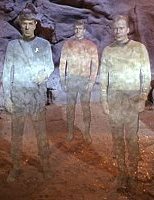There was a young lady named Bright,
Whose speed was far faster than light.
She went out one day,
In a relative way,
And returned the previous night!
Reginald Buller
The term tachyon has often been used in fiction — from the days of the original Star Trek to present day speculative fiction — and I wondered how realistic these faster-than-light particles are; so I did a bit of research… 
Tachyonic particles were theorized in a paper by Gerald Feinberg in 1967 (Possibility of Faster-Than-Light Particles); apparently, he was inspired by James Blish’s short story Beep. In his paper, Feinberg endeavoured to explain the potential microphysical source of tachyons within the bounds of the special theory of relativity.
[Note: Feinberg wasn’t the first to hypothesize faster-than-light particles; that distinction probably dates back to 1904 and a famous German physicist, Arnold Sommerfeld]
In the paper, Feinberg identifies tachyons (from the Greek tachys; swift) as a particle that always travels faster-than-light. He suggested that tachyons may be constituents of a quanta field that has negative squared mass, also termed imaginary mass (the mass is only relevant at speeds faster-than-light). Unlike Bradyons (ordinary matter), as a tachyon’s speed increases, its energy decreases.
Special relativity seems to indicate that if faster-than-light particles exist, they could be used to convey information backward in time, leading to a violation of causality, a fundamental law of physics and logic (logical time-paradoxes would be possible; for example, you could send a message backward in time to have your grandfather murdered).
Currently, tachyon is still used as a term to describe faster-than-light particles (note: the term tachyon is also used to describe a quantum field with imaginary mass); however, theorists quickly discovered that Feinberg’s model couldn’t allow for superluminal velocity. At faster-than-light speeds, the ‘imaginary mass’ would cause tachyon condensation: the system would lower its energy by spontaneously producing particles.
However, in the 1990s, there were experimental results that seemed to indicate the existence of faster-than-light particles…
Photons appear to eclipse the speed-of-light as they ‘tunnel’ through a quantum barrier. The uncertainty principle dictates that a quantum tunneling effect is possible because there is a minute, but theoretical possibility that a photon will materialize on the opposite side of the quantum barrier at a speed that is faster-than-light. Experimental results indicate that this is verifiable; but, according to the paper, “Although the apparent tunneling velocity (1.7 ± 0.2) c is superluminal, this is not a genuine signal velocity, and Einstein’s causality is not violated.” (see Measurement of the Single-Photon Tunneling Time by A. M. Steinberg, P. G. Kwiat, and R. Y. Chiao, Physical Review Letters, Vol. 71, page 708; 1993).
There is also experimental evidence to support the Einstein-Podolsky-Rosen phenomenon that occurs when two ‘partner’ photons that are separated by a large distance can effect each other’s actions instantaneously; hence, each photon seems to exert a faster-than-light influence on its partner. Unfortunately, quantum phenomena are inherently random, uncontrollable, and useless for a communication system (see “High-Visibility Interference in a Bell-Inequality Experiment for Energy and Time,” by P. G. Kwiat, A. M. Steinberg, and R. Y. Chiao, Physical Review A, Vol. 47, page R2472; 1993)
There are theoretical arguments against the existence of faster-than-light tachyon particles and decisive, experimental proof has not been forthcoming, but the search continues. In 2011, the OPERA project at CERN detected faster-than-light neutrinos (and caused quite a stir in the scientific community), but it was later discovered that the fibre-optic timing system was faulty.
Tachyons — negatively squared mass fields — are an intriguing concept in modern theoretical physics, but for now, the possibility of tachyons as a faster-than-light information system, or as a solution to time travel, is only useful as a plot-device in science fiction novels.
For more information:
Scientific American: What is Known About Tachyons…
.
.
.
